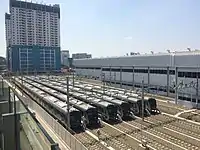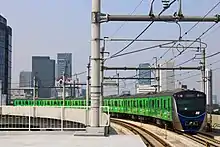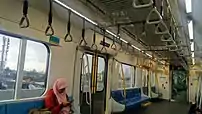Jakarta MRT
The Jakarta Mass Rapid Transit (Indonesian: Moda Raya Terpadu Jakarta[lower-alpha 1]) or Jakarta MRT (MRT Jakarta, stylized as mrt jakarta) is a rapid transit system in Jakarta, the capital city of Indonesia.
 | |||
 Jakarta MRT set 11 departing from Lebak Bulus station | |||
| Overview | |||
|---|---|---|---|
| Native name | Moda Raya Terpadu (MRT) Jakarta[lower-alpha 1] | ||
| Owner | Ministry of Transportation | ||
| Locale | Jakarta, Indonesia | ||
| Transit type | Rapid transit | ||
| Number of lines | 1 | ||
| Number of stations | 13 (North–South line, first phase) | ||
| Daily ridership | 93,000[1] | ||
| Headquarters | Wisma Nusantara, 21st Floor, Jalan Mohammad Husni Thamrin 59, Jakarta, 10350, Indonesia | ||
| Website | MRT Jakarta | ||
| Operation | |||
| Began operation | 24 March 2019 | ||
| Operator(s) | PT Mass Rapid Transit Jakarta (Perseroda) | ||
| Character | Elevated & underground | ||
| Number of vehicles | 16 six-car MRTJ 1000 series trainsets | ||
| Headway | 5 minutes (peak) 10 minutes (off-peak)[2] | ||
| Technical | |||
| System length | 15.7 km (9.8 mi)[3] | ||
| Track gauge | 1,067 mm (3 ft 6 in) (North-South line) 1,435 mm (4 ft 8 1⁄2 in) (West-East line, planned) | ||
| Electrification | 1,500 V DC overhead catenary | ||
| Top speed | 100 km/h (elevated section), 80 km/h (underground section) | ||
| |||
The system is operated by PT Mass Rapid Transit Jakarta (Perseroda), a municipally owned perseroan terbatas of the city of Jakarta. Phase 1 of the project (Lebak Bulus to Bundaran HI) was officially opened on 24 March 2019.[4][5]
Background
Jakarta is the capital city of Indonesia, harbouring 10 million inhabitants, one-third of the population of Greater Jakarta. It is estimated that over four million residents of the surrounding Greater Jakarta area commute to and from the city each working day. Transport issues have increasingly begun to attract political attention and it has been foreseen that without a major transportation breakthrough, the city will have complete traffic gridlock by 2020.[6]
As of 2010, public transportation in Jakarta served only 56% of commuter trips.[7] This figure urgently needs to be raised, as the city's 9.5% average annual growth rate of vehicles far exceeds the increase in road length between 2005 and 2010.[8]
Public transportation now mainly consists of the TransJakarta bus rapid transit system, the World's longest BRT system with a length of 230 kilometers,[9] the KRL Commuterline Metro Jakarta Electrified Train System, Southeast Asia's longest electrified metropolitan transit system with 418 kilometers length consisting of 1 elevated line and 5 at ground level,[10] and various types of independent buses, starting from the very small bemo and pickup-truck sized mikrolet, to slightly larger minibuses such as the widely used MetroMini and Kopaja minibuses and full sized city buses. There are also both two and four wheeled taxis.
Funding
Phase 1 of the project was funded through a soft loan (Rp 16 trillion) from JICA with a 30 years tenure and 0.25% interest per annum.[11] The loan number IP is 536 (signed November 2006) for engineering services. The engineering services loan is a pre-construction loan to prepare the construction phase. It consists of:
- Basic Design package, managed by the DGR (Directorate General of Railways, Ministry of Transport)
- Management and Operation package, managed by the Bappeda (Jakarta Regional Planning Board)
- Construction assistance in tender, managed by the PT MRT Jakarta
Phase 2 was funded through a similar loan scheme with a 40 years tenure, allowing a 10 years grace period. The first stage of phase 2 funding (Rp 9.4 trillion) incurred 0.1% interest per annumn.[12] Phase 2 funding (Rp 25 trillion) will cover a portion of phase 1 excess expenditure (Rp 2.5 trillion).
Network
The Jakarta MRT is expected to stretch across over 108 kilometres, including 26.7 kilometres for the Red line (from Lebak Bulus to Ancol) and 87 kilometres for the Yellow line (from Cikarang to Balaraja).[13]
The following table lists the MRT lines that are currently operational, under construction or planned:
| Colour and Line Name | Phase | Commencement | Terminus | Stations | Length | Depot |
|---|---|---|---|---|---|---|
| Operational | ||||||
| North–South | 1 | 24 March 2019 | Lebak Bulus Bundaran HI |
13 | 15.7 km (9.8 mi) | Lebak Bulus |
| Under construction | ||||||
| North–South | 2A | 2025 2027 |
Bundaran HI Kota |
7 | 5.8 km (3.6 mi) | Lebak Bulus |
| Planned | ||||||
| North–South | 2B | TBA | Kota Ancol |
3 | 5.2 km (3.2 mi) | Ancol Barat |
| East–West | 3A | TBA | Kalideres Cempaka Baru |
TBA | 20.1 km (12.5 mi) | TBA |
| East–West | 3B | TBA | Cempaka Baru Ujung Menteng |
TBA | 11.6 km (7.2 mi) | TBA |

North–South line (Track gauge 1,067mm)


Phase 1
Phase 1 connects Lebak Bulus to Bundaran HI along 15.7 kilometres and consists of 13 stations (7 elevated stations and 6 underground stations).[14] The Indonesian Ministry of Transport approved this plan in September 2010 and invited tenders. Construction began in October 2013.[15]
Phase 1 was opened for free service on 24 March 2019. Commercial service began on 1 April 2019.[16] Phase 1 is expected to serve 212,000 passengers per day. This expected capacity may be maxed out to 960,000 per day. The 15.7 kilometre distance is covered in under 30 minutes.[17] Within its first month of operations, 82,000 passengers used the line daily.[18]
Phase 2
Phase 2 was initially planned to extend Bundaran HI to Kampung Bandan in North Jakarta. However, land acquisition issues hindered the process, prompting the administration to find an alternative location, which will also be designed to house the trains depot.
On 1 January 2019, the president director of MRT Jakarta, William Sabandar said the city administration had decided to make Kota the final station for Phase 2. The extension was then renamed to Phase 2A.
Phase 2A will extend the Red line northwards, from Bundaran HI to Kota and consists of 7 stations over 5.8 kilometres. The extension was initially planned to be fully operational by April 2026. However, due to problems securing bidders for the construction and the effects of the COVID-19 pandemic, the extension is now expected to be fully operational by mid-2027.[19]Phase 2A construction is expected to cost Rp 22.5 trillion.[20]
On 20 February 2019, it was announced that the Red line will be extended further, towards Ancol. The extension was named Phase 2B.[21]
On 17 February 2020, during the signing of contract CP201 for the construction of the first two stations of the Phase 2A extension, the administration announced that Phase 2B will consists of 3 stations and is currently under feasibility studies, with its construction expected to commence in mid-2022.[22]
East–West line (Track gauge 1,435mm)
A second line is planned to run east–west with Standard gauge 1435mm, from Cikarang (West Java) to Balaraja (Banten) via Central Jakarta. It is envisioned to be 87 kilometres long. Just like the Red line, the Yellow line will also be built in phases. The Yellow line is planned to interchange with the Red line at Thamrin Station.[23] [24]
Phase 3
Phase 3 will be 31.7 kilometres long and stretches from Kalideres in West Jakarta to Ujung Menteng in East Jakarta. It is currently under architectural design studies and construction is initially expected to begin in 2020. On 4 February 2020 however, the Minister of Transport, Budi Karya Sumadi mentioned that construction will only begin in 2022 and targets for completion in 2026.
Fares and ticketing

The charged fare for a trip on the MRT starts at Rp 3,000, increasing by Rp 1,000 for every station passed. A trip spanning the entire existing line in 2019 would cost a passenger Rp 14,000.[25]
A refundable Rp 15,000 deposit is required to purchase a single journey ticket, in addition to fares required for the journey.
The Jakarta MRT employs a cashless fare payment system. A dedicated contactless smart card known as the 'Jelajah' can be purchased from the ticketing machines or ticket offices located at every station. Other accepted forms of payment include electronic prepaid cards such as the JakLingko, E-Money, Brizzi, BNI Tap Cash, Flazz, Jakcard. [26]
Passengers are required to tap their cards at the ticket gates when entering and exiting the paid area of the stations.
Safety and security

Half-height Platform Screen Doors (PSDs) are installed at platforms of elevated stations, while full-height Platform Screen Doors are used at platforms of the underground stations.
Trains and stations are equipped with CCTVs, which are monitored from the control room. Medical rooms are also available at every station to provide first-aid to passengers and workers, if necessary.[27] Security officers are regularly stationed at station entrances and platforms.
Rolling stock


Contract CP 108 for the procurement of rolling stock for the Jakarta MRT was awarded to a consortium led by Sumitomo Corporation on 3 March 2015.[28] A total of 16 six-cars trainsets were ordered at a cost of ¥10.8 billion (Rp. 145 billion).[29] The trains were built in Nippon Sharyo's plant in Toyokawa, Aichi.[30]
Each car measures 20 m (65 ft 7 in) in length, 2.9 m (9 ft 6 in) in width, and 3.9 m (12 ft 10 in) in height.[31] These trains utilize the CBTC signaling system and are equipped with Automatic Train Operation (ATO) GoA 2, with drivers operating the doors and driving in case of emergency.[32] Like the KRL Commuterline, the MRT trains are also powered via overhead catenary.[33]
On 10 January 2018, the Governor of Jakarta, Anies Baswedan, gave the first batch of MRT Jakarta trainsets the nickname "Ratangga". The name was derived from the old Javanese word for chariots.[34] It offers a women-only carriage during morning peak hours from 7AM to 9AM and in the afternoon from 5PM to 7PM.[35]
PT Mass Rapid Transit Jakarta
PT MRT Jakarta (Perseroda) is a joint-stock company founded by the Government of Jakarta Province. Its establishment was approved by the provincial parliament (DPRD) on 10 June 2008 and the company was officially incorporated on 17 June 2008. Its purpose is to operate the Jakarta MRT system. 99% of the shares are owned by the Government of Jakarta and 1% by Perumda Pasar Jaya (a municipal public corporation of Jakarta mainly operating marketplaces).

Notes
- lit. "Jakarta Integrated Mass Mode"
References
- Afifa, Laila (1 January 2020). "MRT Jakarta Operates Normally amid Flood". Tempo.
- "Kebajikan Operational MRT Jakarta mulai 29 Agustus 2020". MRT Jakarta.
- "Next Station, Kota: Jakarta MRT Transports 20 Million Passengers in First Eight Months". Jakarta Globe. Retrieved 3 December 2019.
- Bernhart Farras & Chandra Gian Asmara (24 March 2019). "Resmikan MRT Jakarta, Jokowi: Sebuah Peradaban Baru Dimulai".
- "Jakarta metro inaugurated". Metro Report. Retrieved 2 April 2019.
- "Grand plan to beat gridlock". The Jakarta Post. 5 March 2013.
- "Urban Public Transport System in Jakarta (2010)" (PDF). sustainabledevelopment.un.org.
- "United Nations Forum on Climate Change Mitigation, Fuel Economy And Sustainable Development of Urban Transport" (PDF). Urban Public Transport System in Jakarta. Retrieved 20 September 2015.
- "Koridor – PT Transportasi Jakarta". transjakarta.co.id. Retrieved 6 April 2019.
- "Tentang Kami".
- "Indonesia, JICA sign deal on loan for MRT Phase II project". The Jakarta Post. 25 October 2018.
- Simorangkir, Eduardo. "Mengintip Skema Pembayaran Utang Pembangunan MRT Jakarta". detikfinance. Retrieved 11 March 2019.
- "Pondok Cabe-Serpong Bakal Ada MRT, Mulai Dibangun 2022". CNBC Indonesia. Retrieved 6 December 2019.
- "Stasiun dan Fasilitas" (in Indonesian). Retrieved 3 February 2018.
- "MTR Academy Signs Memorandum of Understanding with MRT Jakarta to Support Development of Indonesia's First Mass Transit System" (PDF). MTR. 28 April 2017.
- "Tarif Belum Diketok, Warga Masih Bisa Nikmati MRT Cuma-cuma Sampai Akhir Maret". Merdeka.com. Retrieved 22 December 2017.
- "MRT construction likely to disrupt public utility networks". 7 October 2011.
- Ikhsanudin, Arief (30 April 2019). "Sebulan Operasi, MRT Angkut 82.615 Penumpang Per Hari". detiknews (in Indonesian). Retrieved 4 May 2019.
- "MRT Jakarta phase 2 faces delays amid lack of interest, COVID-19 pandemic". The Jakarta Post. 20 October 2020.
- Farras, Bernhart (24 March 2019). "Pembangunan MRT Jakarta Fase 2 Telan Rp 22,5 T". CNBC Indonesia (in Indonesian). Retrieved 4 April 2019.
- "Lokasi Depo Belum Pasti, Pembangunan MRT Fase II Dibagi 2 Tahap". 18 January 2019.
- "MRT, Adhi Karya, dan Shimizu teken Kontrak MRT Fase 2A". 17 February 2020.
- "MRT Fase III Cikarang – Balaraja akan Mulai Dibangun Kuartal II 2020". 24 March 2019.
- "MRT akan Membentang dari Kalideres Hingga Ujung Menteng". 24 March 2019.
- Tambun, Lenny Tristia (26 March 2019). "Jakarta Sets MRT Ticket Price". Jakarta Globe. Retrieved 31 March 2019.
- "MRT Jakarta opens at half-price fares for April". 1 April 2019.
- "MRT Jakarta gears up for passenger safety". 26 February 2019.
- "Kontrak Rolling Stock Proyek MRT Jakarta Ditandatangani" (PDF) (Press release) (in Indonesian). PT MRT Jakarta. 3 March 2015. Archived from the original (PDF) on 16 March 2015.
- Ady Sukarno, Puput (3 March 2015). "PROYEK MRT JAKARTA: Sumitomo Corporation Menangkan Tender Kereta Listrik". Bisnis.com. Retrieved 23 July 2020.
- Riana, Friski (11 December 2017). "Melihat Kereta MRT Jakarta Diproduksi: Tak Lagi Mirip Jangkrik". Tempo (in Indonesian). Retrieved 4 April 2019.
- "Kereta MRT Jakarta: Untuk Kenyamanan Mobilitas Penumpang". MRT Jakarta (in Indonesian). 16 January 2018. Retrieved 4 April 2019.
- "CBTC: Untuk Keamanan, Kenyamanan, dan Keandalan MRT Jakarta". MRT Jakarta (in Indonesian). 3 December 2017. Retrieved 4 April 2019.
- "MRT Jakarta to be fully operational in 2024". Investor Daily. PwC. 2 July 2018.
- Farozy, Iko Haidar (10 December 2018). "Nama Kereta MRT Jakarta Diresmikan Gubernur DKI". Railway Enthusiast Digest. Retrieved 10 December 2018.
- "MRT Sediakan Satu Kabin Kereta Khusus Penumpang Wanita di Jam-jam Sibuk". Tribunnews.com (in Indonesian). 13 March 2019. Retrieved 4 April 2019.
